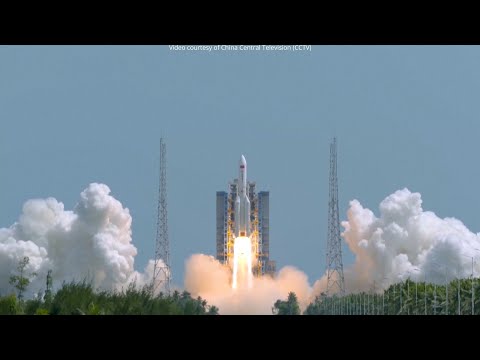HELSINKI — Landspace’s Zhuque-2 rocket suffered an anomaly after liftoff Thursday, leading to loss of the mission and potential delays for its new Zhuque-3 reusable launcher.
The Zhuque-2E methane-liquid oxygen rocket lifted off at around 9:17 p.m. Eastern, Aug. 14 (0117 UTC, Aug. 15) from a dedicated pad at Dongfeng Commercial Space Innovation Test Area at Jiuquan Satellite Launch Center, northwest China.
Amateur video shows the rocket climbing into blue skies above Jiuquan, with a white plume of smoke becoming visible at altitude less than two minutes into the flight.
Landspace confirmed the loss of the mission more than eight hours after liftoff. “The rocket experienced a flight anomaly, resulting in the failure of the flight test mission. The specific cause is under further analysis and investigation,” Landspace said in a statement. The payloads lost on the flight were not disclosed, as is typical in the case of a Chinese launch failure. Landspace expressed sincere apologies to the client for the failure.
The failure could have impacts for the company in a number of ways beyond delaying flights of the Zhuque-2E, if the anomaly was related to the second stage. The company’s new Zhuque-3 uses the TQ-15B vacuum engine on its second stage, an evolution from the TQ-15A on the Zhuque-2E, which likely share design heritage, components and manufacturing processes. This may mean potential delays to the debut of the Zhuque-3, previously expected before the end of the year, until the issue from the launch failure is identified and resolved and fixes validated. This would also have knock-on effects for contracts such as launches for demo cargo missions and the Thousand Sails constellation.
Zhuque-3 is one of a number of potentially reusable commercial and state-owned rockets which could see test flights before the end of the year. These include Tianlong-3 (Space Pioneer), Kinetica-2 (CAS Space), Pallas-1 (Galactic Energy), Gravity-2 (Orienspace), Hyperbola-3, Nebula-1 (Deep Blue Aerospace) and the Long March 12A (CASC).
The blow also comes soon after Landspace filed preliminary documents with the Shanghai Stock Exchange’s tech-focused STAR Market in late July, with the company potentially eyeing an IPO in early 2026.
Last month the China National Space Administration (CNSA) issued new rules to strengthen quality control and supervision across its growing commercial space sector, including launch.
The launch was the sixth launch of the Zhuque-2 series and ended a run of four successful flights. The first, in December 2022, ended in failure, while the second, in July 2023, made the rocket the first methane-fueled launcher to reach orbit globally. It was the third launch of the 2E, or enhanced version, which features a common bulkhead tank structure design and an upgraded TQ-15A engine instead of the earlier TQ-12.
Separate Guowang launch marks surge in constellation deployment
Thursday’s launch failure followed a Long March 5B rocket launch from Wenchang spaceport on Hainan island, successfully sending 10 satellites into orbit for the national Guowang broadband constellation.
A Long March 5B with a Yuanzheng-2 upper stage lifted off at 2:43 a.m. Eastern (0643 UTC) Aug. 13, according to CASC.
The satellites were inserted into roughly 1,100-kilometer-altitude orbits inclined by 86 degrees. The launch marked the fourth Guowang mission inside three weeks, marking a sharp uptick in launch cadence for the project. A Long March 6A launch scheduled to launch from Taiyuan Aug. 17 could add to this accelerated pace.
The 10 satellites were provided by the China Academy of Space Technology (CAST), the major spacecraft maker under the state-owned giant space contractor CASC. Guowang will consist of nearly 13,000 satellites in low Earth orbit. The near-term target for Guowang is to have 400 satellites in orbit by 2027.
The Long March 6A was used for the first of the recent missions July 28, followed by launches of the Long March 8A and Long March 12, both flying from the Hainan Commercial Space Launch Center near Wenchang spaceport. The latter was the first such mission to fly satellites provided for Guowang by a commercial satellite manufacturer.
The Long March 5 series was developed to launch large satellites to geosynchronous orbit and for flagship lunar and planetary missions. The LEO variant Long March 5B was designed to launch modules for the Tiangong space station and potentially be used for launching the Mengzhou crew spacecraft.
The latter has now been repurposed and bundled with a YZ-2 upper stage to help construct Guowang. While Tiangong module launches saw the huge Long March 5B first stage enter orbit and make uncontrolled reentries, the YZ-2 upper stage inserts the satellites into their intended LEO orbits, meaning the first stage remains suborbital and splashes down in a predetermined area.
The Long March 5B and Zhuque-2E launches were China’s 44th and 45th orbital launch attempts of the year, with the Zhuque-2E marking the first failure. China is currently on pace to surpass its national record of 68 launch attempts in a calendar year, set in 2024.


